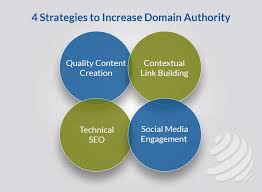
1. Understanding Domain Authority (DA)
1.1 What Is Domain Authority?
Domain Authority (DA) is a metric developed by Moz to gauge a website’s ability to rank on search engine results pages (SERPs). It ranges from 1 to 100, with higher scores indicating better potential rankings. Think of it as a measure of your website’s “reputation” in the vast world of the internet.
1.2 Why Is DA Important?
DA is crucial because it gives an overview of how well your site can compete for visibility in search results. A higher DA means:
- Better chances of ranking for competitive keywords.
- Increased organic traffic potential.
- Enhanced credibility among users and search engines.
1.3 How Is DA Calculated?
Moz calculates DA using over 40 factors, including:
- Backlink quality: High-authority links improve your score.
- Domain age: Older domains often have higher DA.
- Traffic metrics: Consistent traffic boosts your DA.
It’s worth noting that DA is relative—it’s more valuable when compared to competitors.
1.4 Common Myths About DA
- “Google uses DA directly.” Nope! Google has its own ranking factors, and DA is not one of them.
- “High DA guarantees rankings.” While helpful, DA alone doesn’t ensure top positions on SERPs.
- “You can buy DA improvements.” Spoiler alert: It’s not that simple (or ethical).
2. Factors That Influence Domain Authority

2.1 Quality Backlinks
Not all backlinks are created equal. A link from Forbes carries more weight than one from a random blog. Focus on earning:
- Links from reputable sources.
- Diverse anchor texts to avoid penalties.
- Natural and relevant links.
2.2 Content Quality and Relevance
Google loves fresh, insightful, and user-focused content. Some tips:
- Write for humans, not search engines.
- Cover trending topics in your niche.
- Regularly update old posts with new information.
2.3 User Experience (UX) and Site Structure
A good UX is essential:
- Navigation: Make it intuitive.
- Speed: Faster sites rank better.
- Mobile-friendliness: Optimize for smartphones.
2.4 Social Signals and Brand Presence
While indirect, social media impacts DA:
- Drive traffic through engaging posts.
- Build brand mentions and citations.
- Encourage user shares to amplify content reach.
3. Strategies to Increase Domain Authority

3.1 Building High-Quality Backlinks
Quality over quantity. Ways to build:
- Guest blogging: On high-authority sites.
- Broken link building: Offer your content as a replacement.
- Collaborations: Partner with influencers or brands.
3.2 Creating SEO-Optimized Content
Your content should:
- Address user intent.
- Include relevant keywords (naturally).
- Be formatted for readability (headings, bullet points).
3.3 Optimizing Site Performance and Security
Don’t overlook technical aspects:
- Use HTTPS for secure browsing.
- Minimize loading times with compressed images and caching.
- Fix crawl errors using Google Search Console.
3.4 Promoting Your Website on Social Media
Boost visibility by:
- Sharing blog posts on multiple platforms.
- Engaging with followers through comments and DMs.
- Running targeted ad campaigns.
4. Tools to Monitor and Improve DA
4.1 Moz Link Explorer
Moz’s flagship tool for tracking backlinks and DA trends.
4.2 Ahrefs Domain Rating
Offers insights into your backlink profile and competitor analysis.
4.3 Google Analytics and Search Console
Track traffic, resolve technical issues, and find content opportunities.
4.4 SEMrush Backlink Analytics
Analyze referring domains and their impact on your rankings.
5. Common Mistakes to Avoid
5.1 Purchasing Backlinks
It might seem like a quick fix, but buying backlinks can backfire big time. Here’s why:
- Google penalizes unnatural link-building practices.
- Purchased links are often low-quality and irrelevant.
- They can damage your reputation if flagged.
Instead, focus on earning backlinks organically through quality content and outreach.
5.2 Ignoring Mobile Optimization
With over half of web traffic coming from mobile devices, a non-mobile-friendly site is a dealbreaker.
- Use responsive design to ensure content displays correctly on all screens.
- Test your site with Google’s Mobile-Friendly Test tool.
- Prioritize mobile page speed for better user experience.
5.3 Overlooking Internal Linking
Internal links are the unsung heroes of SEO. They:
- Help search engines crawl and index your site.
- Distribute link equity across pages.
- Improve user navigation by guiding readers to related content.
Make it a habit to interlink blog posts and pages with relevant anchor text.
5.4 Not Updating Content Regularly
Outdated content can hurt your rankings and DA. To keep things fresh:
- Review older posts periodically.
- Update statistics, examples, or broken links.
- Repurpose successful content into new formats like videos or infographics.
6. Real-Life Examples of Websites With High DA
6.1 Corporate Giants (e.g., Amazon, Wikipedia)
Big players like Amazon and Wikipedia dominate with DA scores near 100. How do they do it?
- Amazon: Boasts high-quality backlinks from e-commerce blogs, forums, and news outlets.
- Wikipedia: Maintains DA by providing valuable, verifiable, and widely-linked content.
6.2 Niche Blogs and Their DA Journey
Even small blogs can achieve impressive DA scores with the right strategies. For instance:
- Tech blogs: Attract links by publishing in-depth gadget reviews.
- Food blogs: Gain traffic through recipe sharing and collaborations.
These sites prove that niche focus combined with consistent effort pays off.
6.3 Case Studies of Improved DA
Consider this case:
- A travel blog improved its DA from 20 to 45 within a year by:
- Publishing weekly destination guides.
- Building backlinks through guest posts.
- Leveraging Pinterest to increase traffic.
6.4 Lessons Learned From Successful Websites
- Quality beats quantity in backlinks.
- Regular updates keep users and search engines engaged.
- A strong social media presence drives consistent traffic.
7. The Long-Term Approach to Sustaining High DA
7.1 Continuous Content Updates
Never let your content stagnate. Stay on top of trends and user demands by:
- Writing follow-ups to popular posts.
- Adding multimedia elements like videos or podcasts.
- Incorporating user feedback into new content ideas.
7.2 Regular Technical Audits
Performing audits ensures your site runs smoothly. Key areas to check:
- Broken links and redirect chains.
- Slow-loading pages or oversized images.
- Errors in robots.txt or sitemap files.
7.3 Staying Updated With Algorithm Changes
Search engine algorithms evolve constantly.
- Follow reliable SEO blogs like Moz, Ahrefs, or Neil Patel.
- Experiment with new strategies to adapt to changes.
- Monitor traffic dips to identify potential algorithm hits.
7.4 Building Community and Trust Online
A loyal community can indirectly boost your DA:
- Reply to comments on your blog and social posts.
- Encourage reviews and testimonials.
- Offer value through free resources, like eBooks or templates.
Conclusion
Improving your website’s domain authority is a long-term investment, not an overnight miracle. By focusing on quality backlinks, creating exceptional content, optimizing your site, and avoiding common pitfalls, you can steadily climb the DA ladder. Remember, consistency is key, and every small step you take contributes to building a credible and authoritative online presence.
FAQs
1. Can I check my DA for free?
Yes, tools like Moz’s Link Explorer offer free checks, though with limited features.
2. Does domain age affect DA?
Yes, older domains often have higher DA due to accumulated backlinks and authority.
3. What’s the difference between DA and DR?
DA (Domain Authority) is by Moz, while DR (Domain Rating) is by Ahrefs. Both measure backlink strength but use different scales.
4. Should I focus only on DA?
No, prioritize creating value for your audience. DA is just one metric; user experience and engagement matter too.
5. How often does DA update?
Moz updates DA periodically, usually every few weeks.
